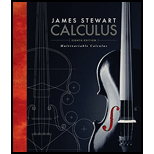
We have seen that all
[Hint: Let G(x, y, z) = ⟨g(x, y, z), 0, 0⟩, where
Want to see the full answer?
Check out a sample textbook solution
Chapter 16 Solutions
Multivariable Calculus
- Ministry of Higher Education & Scientific Research Babylon University College of Engineering- Al musayab Subject :Numerical Analysis Stage:Third Time: 2 hour Automobile Department Date:26-3-2023 nd 1st month exam/2" semester (2022-2023) Note: Answer all questions, all questions have same degree. Q1: Use Newton's method to find solutions to the system with two step Take (X,Yo)=(8,10). { x35x2 + 2xy + 13 = 0 x3 + x²-14x-y-19=0 Q2/:Solve the system by Gauss-Seidel iterative method.(Perform only three iterations). 8x-3y+2z-20 4x+11y-z-33 6x+3y+12z-35 03/:Curve fit the data using a power function X 2 4 8 5 6 0.7500 0.1875 0.1200 0.0833 0.0469arrow_forwardUniversity of Babylon Faculty of Engineering-AlMusyab Automobile Eng. Dep. Year: 2022-2023, 2nd Course, 1 Attempt Stage: Third Subject: Numerical Analysis Date: 2023\\ Time: 3 Hour dy = x + yl Q5-A: Using Euler's method, find an approximate value of (y) corresponding to (x=0.3),given that[- and [y=1 when x=0].(taking h=0.1). dx (10 M) Q5-B Find a root of an equation[f(x)=x-x-1] using Newton Raphson method to an accuracy of &=0. (10 M) Q6:Using Newton's divided differences formula, evaluate f(8) given: X 4 58 7 103 11 13 Y=f(x) 48 100 900 294 1210 2028 (20 M) Lexaminer: Examiner: Good luck W Head of Department:arrow_forwardExplain the conditions under which the Radius of Convergence of the Power Series is a "finite positive real number" r>0arrow_forward
- This means that when the Radius of Convergence of the Power Series is a "finite positive real number" r>0, then every point x of the Power Series on (-r, r) will absolutely converge (x ∈ (-r, r)). Moreover, every point x on the Power Series (-∞, -r)U(r, +∞) will diverge (|x| >r). Please explain it.arrow_forwardExplain the conditions under which Radious of Convergence of Power Series is infinite. Explain what will happen?arrow_forwardExplain the conditions under Radius of Convergence which of Power Series is 0arrow_forward
- Explain the key points and reasons for 12.8.2 (1) and 12.8.2 (2)arrow_forwardQ1: A slider in a machine moves along a fixed straight rod. Its distance x cm along the rod is given below for various values of the time. Find the velocity and acceleration of the slider when t = 0.3 seconds. t(seconds) x(cm) 0 0.1 0.2 0.3 0.4 0.5 0.6 30.13 31.62 32.87 33.64 33.95 33.81 33.24 Q2: Using the Runge-Kutta method of fourth order, solve for y atr = 1.2, From dy_2xy +et = dx x²+xc* Take h=0.2. given x = 1, y = 0 Q3:Approximate the solution of the following equation using finite difference method. ly -(1-y= y = x), y(1) = 2 and y(3) = −1 On the interval (1≤x≤3).(taking h=0.5).arrow_forwardConsider the function f(x) = x²-1. (a) Find the instantaneous rate of change of f(x) at x=1 using the definition of the derivative. Show all your steps clearly. (b) Sketch the graph of f(x) around x = 1. Draw the secant line passing through the points on the graph where x 1 and x-> 1+h (for a small positive value of h, illustrate conceptually). Then, draw the tangent line to the graph at x=1. Explain how the slope of the tangent line relates to the value you found in part (a). (c) In a few sentences, explain what the instantaneous rate of change of f(x) at x = 1 represents in the context of the graph of f(x). How does the rate of change of this function vary at different points?arrow_forward
- 1. The graph of ƒ is given. Use the graph to evaluate each of the following values. If a value does not exist, state that fact. и (a) f'(-5) (b) f'(-3) (c) f'(0) (d) f'(5) 2. Find an equation of the tangent line to the graph of y = g(x) at x = 5 if g(5) = −3 and g'(5) = 4. - 3. If an equation of the tangent line to the graph of y = f(x) at the point where x 2 is y = 4x — 5, find ƒ(2) and f'(2).arrow_forwardDoes the series converge or divergearrow_forwardDoes the series converge or divergearrow_forward
- Algebra & Trigonometry with Analytic GeometryAlgebraISBN:9781133382119Author:SwokowskiPublisher:Cengage
